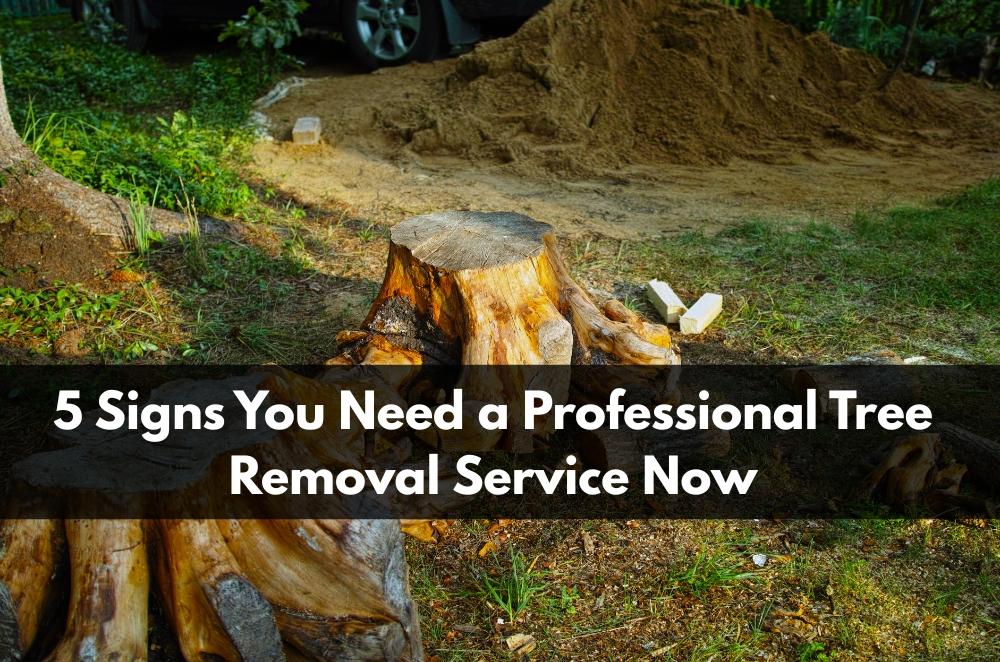5 Signs You Need a Professional Tree Removal Service Now

A problem tree rarely fails without sending warnings first—lean that worsens after rain, bark splitting under load, or roots nudging up pavers where people walk. If safety and access are on the line, speed matters, but so does method. In suburban blocks, I’ve found it’s often calmer and cheaper to plan early rather than rush after a storm. When the goal is a safe, tidy outcome with minimal site disturbance, leaning on tree removals is usually the practical path: scoped, sequenced, and set up for clean reinstatement.
Five signs it’s time to call a pro
You don’t need specialist gear to spot risk. Two minutes with a notepad can tell you whether the situation is changing fast enough to warrant professional help.
-
Progressive lean: Angle increases after wet or windy days: roots may be losing purchase and need assessment.
-
Deadwood shedding: High, dry branches drop with light wind: unseen decay aloft raises strike risk below.
-
Root uplift: Pavers, soil, or edging heave upward: lateral roots are pressing on structures and services.
-
Fungal clues: Brackets or conks at the base: internal decay may be advanced despite a leafy crown.
I’ve viewed trees that looked “fine” at street level yet failed a simple ground test—soft, spongy soil around the base after rain. Small checks like these move a decision from gut feel to evidence.
Safety and compliance you can’t ignore
Good operators design for safety before the saws start. That means planning drop zones, isolating work areas, and aligning with local standards so neighbours and property are protected.
-
Site controls: Barriers, spotters, and clear walk paths: everyone nearby knows where they can (and can’t) be.
-
Service locating: Underground utilities and irrigation marked first: surprises are rare and manageable.
-
Traffic and verge: Public interfaces managed cleanly: cones, marshals, and permits where relevant.
-
Waste pathway: Green waste is separated and moved safely: trucks, chippers, and foot traffic don’t clash.
If you want a straight, no-drama reference for public expectations, local guidance on tree management lays out principles that influence pruning, removals, and how the urban canopy is protected across seasons.
Choosing a service that suits your site
Not every crew is right for every block. Tight access, nearby glazing, and shared driveways encourage smaller gear and surgical sequencing; open sites can go faster with heavier plant.
-
Access fit: Measure gate widths and steps: compact climber crews or spider lifts may beat large cranes on small lots.
-
Method match: Sectional dismantle vs felling: the choice depends on lean, targets, and wind exposure.
-
Protection plan: Mats on lawns and ply over pavers: ground recovers quickly, and edges stay intact.
-
Aftercare brief: Backfill, light compaction, and mulch plan: the area settles level and drains properly.
For a broader context on what full-service arborists cover—surveys, risk ratings, and maintenance cycles—look for tree arborist services in Melbourne; it helps you scope a sensible package instead of piecemeal visits.
Costs, quotes, and what affects price
Price follows time, risk, and logistics. Two similar trees can vary widely if one overhangs a roof and the other stands clear above the lawn.
-
Risk profile: Proximity to roofs, glass, or lines: higher consequence increases rigging and supervision.
-
Logistics map: Chip truck access, carry distance, and parking rules: moving green waste is half the work.
-
Timber hardness: Species, diameter, and defects: tougher wood and awkward forks slow clean cuts.
-
Waste choice: Mulch-on-site vs cart-away: disposal fees and time stack quickly on big canopies.
I once compared two quotes that seemed far apart until we mapped the carry distance: one crew had a straight, short path to the truck; the other had 40 metres of tight turns. That single detail explained the gap. For a level-headed take on why quote totals differ, perspectives on quoting tree work outline how operators weigh risk, gear, and access before naming a price.
What removal day actually looks like
Knowing the sequence reduces stress. When you can anticipate each step, the hum of saws feels like a plan, not chaos.
-
Brief and checks: Crew walk-through and gear test: everyone knows cuts, rigging points, and escape paths.
-
Crown reduction: Top-down sectional cuts rigged and lowered: targets protected and load paths controlled.
-
Stem and stump: Trunk sections stacked, then stump cut low: grinder booked if below-grade finish is needed.
-
Tidy and reinstate: Chips moved, paths swept, and ground topped: photos taken for your records.
I shadowed a removal where the foreman paused mid-job to reposition mats after a passing shower. That five-minute reset saved the lawn from rutting and kept the clean-up short.
Aftercare that protects your yard (and budget)
The job isn’t done when the truck leaves. A couple of light touches over the next fortnight will help the area settle evenly and keep pests uninterested.
-
Level watch: Top up low spots as chips settle: small additions prevent trip edges in fresh turf.
-
Moisture sense: Water lightly if you’re replanting: roots prefer even moisture over big dumps.
-
Pest hygiene: Move sweet, fresh chips away from timber structures: borers and ants will take the hint.
-
Future planning: Note species and location for the next plant: choose root behaviour that suits paving and drains.
I revisit repaired patches a week later with a shovel and a bag of soil; five minutes of top-up makes the lawn look like nothing happened.
Bringing it together
Urgency and order can exist together. If your notes point to progressive lean, deadwood overhead, or roots lifting the built environment, treat it as a planning problem first. Map access, targets, and waste paths; choose a crew whose gear fits the realities of your block; and write the outcome you want—depth, reinstatement, and any chip handling—onto the quote so there’s no guesswork. Align with local expectations on safety and canopy care, then let professionals sequence the day: rig, cut, lower, tidy. With that rhythm, removal becomes a controlled operation rather than a noisy gamble, and your yard returns to level ground without drama. The clearest sign you got it right? A week later, you’re walking across the space without thinking about what used to be there.







